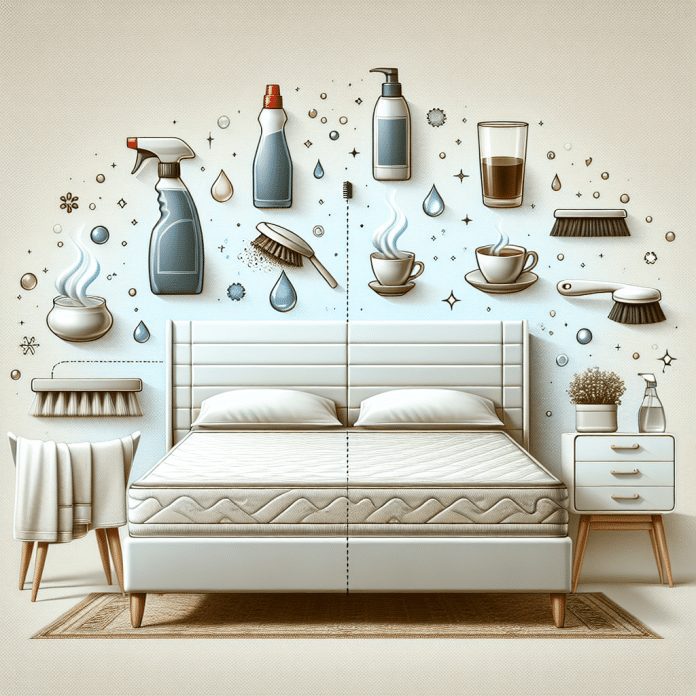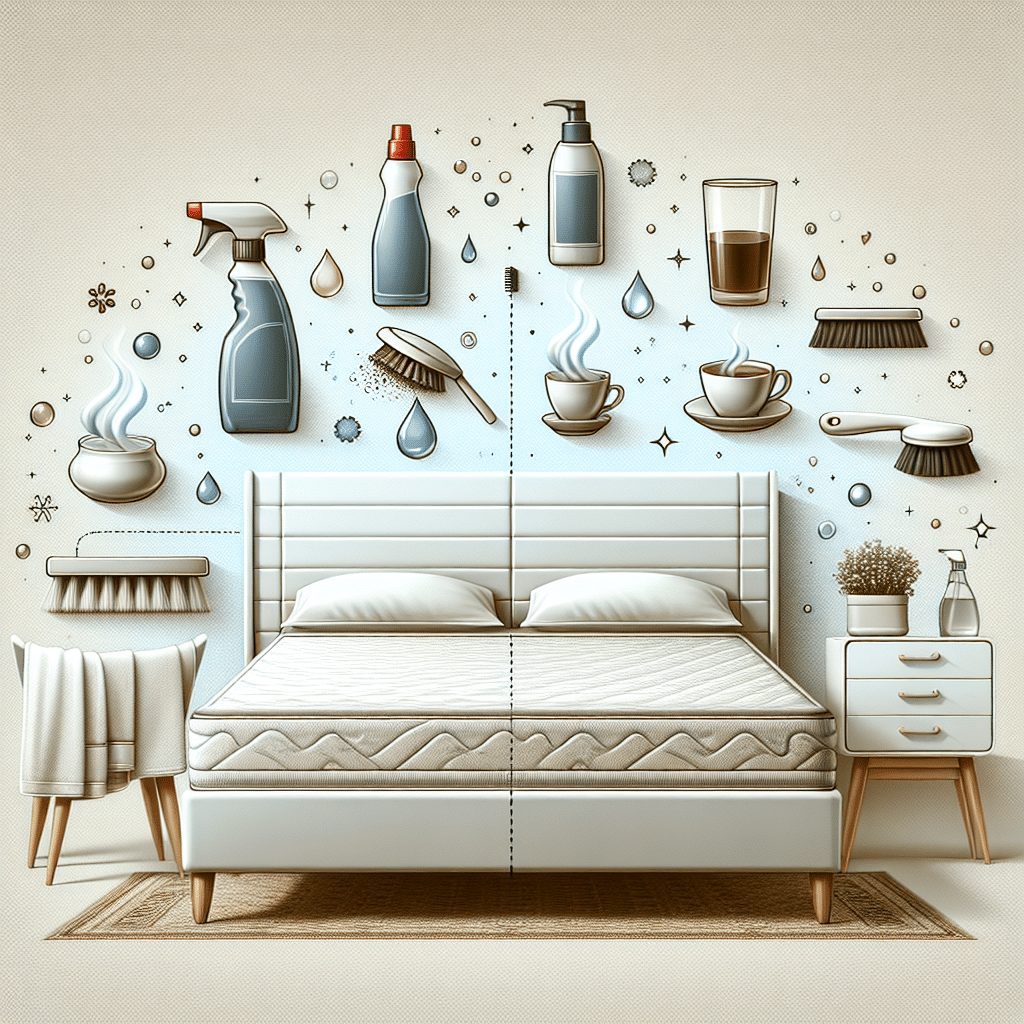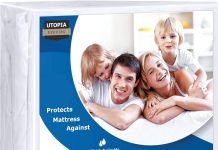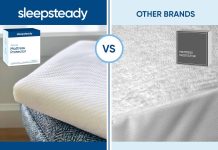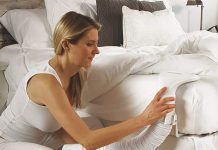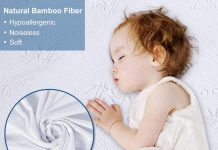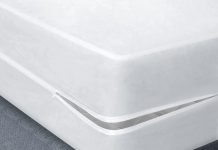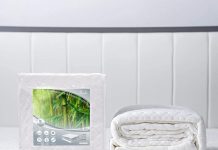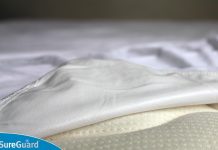We all want to keep our mattresses clean and fresh, and a mattress protector is a great tool to help us achieve that. But when it comes to cleaning the mattress protector itself, some of us are left wondering how to go about it. Well, fear not! In this article, we will share some easy and effective ways to clean your mattress protector, so you can sleep peacefully knowing that your sleep sanctuary is clean and hygienic.
Review contents
Removing Stains from a Mattress Protector
Identify the type of stain
When it comes to removing stains from a mattress protector, the first step is to identify the type of stain you are dealing with. Different stains require different cleaning methods, so it is important to properly assess the situation before proceeding.
Pre-treat the stain
Before getting into the actual cleaning process, it is recommended to pre-treat the stain to help loosen it up and make it easier to remove. This can be done by gently blotting the stain with a clean cloth or paper towel to absorb any excess liquid or residue.
Use cold water for blood or urine stains
For blood or urine stains, it is best to use cold water when cleaning. Cold water helps prevent the stain from setting and spreading further. Simply soak the stained area in cold water for about 30 minutes, then proceed to the next step.
Apply a mild detergent for food or beverage stains
To tackle food or beverage stains on a mattress protector, it is advisable to use a mild detergent. Dilute the detergent in water according to the instructions and apply it to the stained area. Gently rub the fabric together to work the detergent into the stain.
Spray hydrogen peroxide for sweat stains
Sweat stains can be quite stubborn, but they can be effectively treated with hydrogen peroxide. Fill a spray bottle with hydrogen peroxide and spray it directly onto the stain. Allow it to sit for a few minutes to break down the stain before proceeding to the next step.
Spot clean with a fabric cleaner for oil or grease stains
Oil or grease stains require a different approach. Spot clean the affected area with a fabric cleaner specifically designed for removing oil or grease stains. Apply the cleaner directly to the stain and gently blot it with a clean cloth or sponge.
Gently scrub the stain with a soft brush
After pre-treating the stain and applying the appropriate cleaning solution, it’s time to gently scrub the stain with a soft brush. Use circular motions and moderate pressure to work the cleaning solution into the fabric and remove the stain.
Rinse the area thoroughly
Once the stain has been effectively scrubbed, it is important to rinse the area thoroughly to remove any residue or cleaning solution. Use clean water and gently rinse the stained area until the water runs clear.
Repeat the process if necessary
Some stains may require multiple rounds of cleaning to be completely removed. If the stain persists after the initial cleaning, repeat the pre-treat, cleaning, and rinsing steps until the stain is no longer visible.
Allow the mattress protector to air dry
After successfully removing the stain, it is essential to allow the mattress protector to air dry completely. Hang it in a well-ventilated area or lay it flat on a clean surface. Avoid using heat sources or direct sunlight, as they can damage the fabric.
Washing a Mattress Protector
Check the care label
Before washing a mattress protector, it is crucial to check the care label for specific instructions. The care label provides valuable information on how to properly clean and maintain the mattress protector. Following the guidelines outlined on the care label ensures that the cleaning process is safe and effective.
Unzip or remove the mattress protector
If the mattress protector is removable, unzip or remove it from the bed. This step allows for a thorough cleaning and prevents any damage that may occur during the washing process.
Pre-treat stains before washing
Similar to the stain removal process mentioned earlier, it is recommended to pre-treat any noticeable stains on the mattress protector before proceeding with the washing. This will help ensure that the stains are thoroughly removed during the cleaning process.
Machine wash or hand wash according to instructions
Depending on the care label instructions, the mattress protector can be either machine washed or hand washed. If machine washing is acceptable, use a gentle cycle and set the water temperature as indicated on the care label. If hand washing is recommended, fill a basin or sink with lukewarm water and a mild detergent.
Use a gentle cycle and mild detergent
When machine washing a mattress protector, it is crucial to select a gentle cycle to prevent any damage to the fabric. Additionally, it is important to use a mild detergent specifically designed for delicate fabrics. Avoid using harsh chemicals or strong detergents, as they can cause discoloration or damage to the mattress protector.
Avoid using bleach or fabric softeners
Bleach and fabric softeners should be avoided when washing a mattress protector. Bleach can weaken the fabric and cause discoloration, while fabric softeners can leave a residue that reduces the effectiveness of the mattress protector’s protective properties.
Rinse the mattress protector thoroughly
After the washing cycle is complete, thoroughly rinse the mattress protector to remove any leftover detergent. Ensure that all soap residue is removed to prevent any potential skin irritation or discomfort.
Wring out excess water
Before drying the mattress protector, gently wring out any excess water. Be careful not to twist or wring the fabric too forcefully, as this can damage the fibers and affect the overall quality of the protector.
Dry the mattress protector
When drying a mattress protector, it is best to allow it to air dry. Hang it in a well-ventilated area or lay it flat on a clean surface. Avoid using direct heat sources, such as radiators or dryers, as excessive heat can shrink or warp the fabric.
Reinstall or rezip the mattress protector
Once the mattress protector is completely dry, reinstall or rezip it onto the mattress. Ensure that it is securely fitted to provide optimal protection and comfort.
Regular Maintenance of a Mattress Protector
Vacuum the mattress protector
Regularly vacuuming the mattress protector helps remove dust, hair, and other debris that may accumulate over time. Use a vacuum cleaner with a soft brush attachment to gently remove any surface particles from the protector.
Spot clean stains as soon as possible
Addressing stains promptly is essential to prevent them from setting in and becoming more challenging to remove. When spills or accidents occur, immediately spot clean the affected area by following the stain removal process mentioned earlier.
Consider using a mattress protector cover
To further protect the mattress protector from stains and spills, consider using a mattress protector cover. This additional layer adds an extra barrier against potential damage and makes cleaning easier.
Rotate the mattress protector regularly
Rotating the mattress protector regularly promotes even wear and tear. By flipping the mattress protector, you ensure that both sides receive equal exposure to pressure and prevent premature deterioration.
Follow the manufacturer’s recommendations
Manufacturers often provide specific guidelines for the maintenance of their mattress protectors. It is essential to follow these recommendations to ensure the longevity and effectiveness of the product.
Avoid eating or drinking on the bed
To minimize the risk of spills and stains, it is best to avoid eating or drinking on the bed. By establishing this habit, you can help keep your mattress protector cleaner for longer periods.
Keep pets away from the mattress protector
Pets can be a source of stains and odors on mattress protectors. To maintain a clean and odor-free protector, it is advisable to keep pets away from the bed or use a pet bed or cover to prevent contact.
Use a mattress topper for extra protection
Adding a mattress topper can provide an extra layer of protection for your mattress protector. The topper acts as a buffer between the sleeper and the protector, reducing the likelihood of stains or spills.
Replace the mattress protector when necessary
No matter how well-maintained a mattress protector is, it will eventually wear out. Monitor the condition of your mattress protector regularly and replace it when you notice signs of wear, such as thinning fabric, tears, or reduced waterproofing abilities.
Frequently wash pillowcases and sheets
Maintaining a clean sleeping environment involves regularly washing pillowcases and sheets. By keeping these items clean, you reduce the likelihood of dirt, oils, or other substances transferring onto the mattress protector.
Dealing with Allergens and Odors
Hypoallergenic mattress protectors
For individuals with allergies or sensitivities, hypoallergenic mattress protectors can be a great solution. These protectors are designed to minimize exposure to common allergens and provide a cleaner, healthier sleep environment.
Use baking soda to neutralize odors
Baking soda is a natural and effective odor neutralizer. Sprinkle baking soda over the mattress protector and let it sit for several hours to absorb any unwanted odors. Afterward, vacuum the baking soda off the protector.
Spray an enzyme cleaner for pet-related odors
If you have pets and notice lingering pet-related odors on the mattress protector, consider using an enzyme cleaner. Enzyme cleaners contain enzymes that break down organic matter, effectively eliminating odor-causing bacteria.
Air out the mattress protector
Allowing the mattress protector to air out can help freshen it up and reduce any lingering odors. Hang it outdoors or in a well-ventilated area, ensuring it is protected from direct sunlight.
Store the mattress protector in a dry and clean place
If you need to store your mattress protector temporarily, make sure to store it in a dry and clean place. Moisture and dust can contribute to the growth of mold and mildew, which can cause unpleasant odors.
Consider professional cleaning for stubborn odors
If odors persist despite your best efforts, consider seeking professional cleaning services. Professional cleaners have specialized equipment and expertise to tackle stubborn odors effectively.
Keep the bedroom well-ventilated
Maintaining proper ventilation in the bedroom helps minimize odors and prevents the buildup of allergens. Open windows or use fans to promote air circulation and freshen the sleeping environment.
Avoid using strong chemicals or perfumes
While it may be tempting to use strong chemicals or perfumes to mask odors, it is best to avoid them. These substances can irritate the respiratory system and may worsen allergies or sensitivities.
Use essential oils for a fresh scent
For a natural and pleasant scent, consider using essential oils. Add a few drops of your favorite essential oil to a spray bottle filled with water and lightly mist the mattress protector. Remember to test a small, inconspicuous area to ensure the oil doesn’t stain or damage the fabric.
Consult a professional for severe allergies
If you suffer from severe allergies or have specific concerns about allergens, it is wise to consult with a professional, such as an allergist or healthcare provider. They can provide personalized advice and recommendations for managing allergies effectively.
Preventing Bed Bug Infestation
Inspect the mattress protector regularly
Regularly inspect the mattress protector for any signs of bed bugs, such as tiny dark spots or rust-colored stains. Bed bugs are tiny pests that hide in seams, crevices, and cracks.
Encase the mattress protector in a bed bug-proof cover
To prevent bed bugs from infesting your mattress protector, consider encasing it in a bed bug-proof cover. These covers create a barrier that hinders bed bugs from accessing the protector and infesting it.
Avoid placing luggage or bags on the bed
When traveling or returning from a trip, avoid placing luggage or bags directly on the bed. Bed bugs can hitch a ride on these items and find their way into the mattress protector and other bedding.
Wash and dry bedding on high heat
To eliminate any potential bed bugs or their eggs, wash your bedding, including the mattress protector, on high heat. Bed bugs cannot survive extreme temperatures, so washing and drying at high heat effectively kills them.
Vacuum the mattress and surrounding area
Regularly vacuuming the mattress and the surrounding area helps remove any bed bugs or eggs that may be present. Use a vacuum cleaner with a nozzle attachment to reach into crevices and seams where bed bugs may hide.
Monitor for signs of bed bugs
Be vigilant and monitor for signs of bed bug activity, such as bite marks on your body or blood stains on the sheets. Early detection is crucial for effective bed bug control.
Consider professional pest control if needed
If you suspect or confirm a bed bug infestation in your mattress protector, it is advisable to seek professional pest control services. These professionals have the expertise and resources to eradicate bed bugs safely and effectively.
Avoid bringing used furniture into the bedroom
Used furniture, especially mattresses or bed frames, can be a potential source of bed bugs. Avoid bringing in second-hand furniture into your bedroom without thoroughly inspecting it for signs of infestation.
Seal cracks and crevices in the bedroom
Sealing cracks and crevices in the bedroom with caulk or sealant can help prevent bed bugs from entering or hiding in these areas. Pay attention to baseboards, electrical outlets, and any other potential entry points.
Educate yourself about bed bug prevention
Staying informed about bed bug prevention strategies is essential. Educate yourself about the signs of infestation, prevention methods, and treatment options to effectively protect your mattress protector and ensure a bed bug-free environment.
Removing Mold and Mildew
Identify mold or mildew on the mattress protector
Mold and mildew are common culprits for musty odors and discoloration on a mattress protector. Identify any visible mold or mildew on the protector before proceeding with the cleaning process.
Safety precautions for mold removal
When dealing with mold or mildew, it is essential to take safety precautions to protect yourself and prevent spreading the spores. Wear gloves, a mask, and eye protection to minimize contact with the mold and avoid inhaling spores.
Remove the mattress protector from the bed
Before tackling mold or mildew, remove the mattress protector from the bed to prevent the spores from spreading to other surfaces. Take it outside or into a well-ventilated area for cleaning.
Brush off any loose mold or mildew
Using a soft brush, gently brush off any loose mold or mildew from the mattress protector. Be careful not to scrub too vigorously, as this can drive the spores deeper into the fabric.
Spot clean the affected areas
Create a mixture of equal parts vinegar and water or use a commercial mold and mildew cleaner. Apply the solution to the affected areas of the mattress protector and allow it to sit for a few minutes to penetrate the mold.
Use a mixture of vinegar and water for mildew
For mildew, a mixture of vinegar and water can be effective in removing stains and killing spores. Spray or apply the vinegar and water solution to the affected areas of the mattress protector and let it sit for a few minutes.
Apply hydrogen peroxide for stubborn mold
For stubborn mold stains, hydrogen peroxide can be used as a more potent solution. Consider using a spray bottle to apply hydrogen peroxide directly to the affected areas, allowing it to penetrate the mold or mildew.
Sun-dry or air-dry the mattress protector
After spot cleaning the mold or mildew, it is important to thoroughly dry the mattress protector. Sun-drying is highly effective due to the natural disinfecting abilities of sunlight. If sun-drying is not possible, air-drying in a well-ventilated area is the next best option.
Check for any remaining mold or mildew
Once the mattress protector is dry, inspect it carefully for any remaining mold or mildew. If any traces are still present, repeat the cleaning process or consider seeking professional assistance.
Take preventive measures against future growth
To prevent future mold or mildew growth, ensure that the mattress protector is completely dry before storing it. Additionally, maintain proper ventilation in the bedroom, control humidity levels, and address any moisture issues promptly.
Special Care for Waterproof Mattress Protectors
Wipe away spills and stains immediately
One of the main benefits of a waterproof mattress protector is its ability to repel liquids. However, it is still important to wipe away any spills or stains immediately to prevent them from seeping into the fabric and potentially causing damage.
Follow the manufacturer’s instructions
Each waterproof mattress protector may have specific care instructions provided by the manufacturer. It is crucial to read and follow these instructions to ensure the longevity and effectiveness of the waterproofing properties.
Regularly test the waterproof functionality
To ensure that the waterproof functionality of the mattress protector is intact, periodically test it by pouring a small amount of water onto the surface. If the water beads up and rolls off, the protector is working properly. If the water seeps through, it may be time to consider replacing it.
Avoid excessive heat or direct sunlight
Exposing a waterproof mattress protector to excessive heat or direct sunlight can potentially damage the waterproofing layer. Avoid drying the protector under direct sunlight or using high heat settings when drying.
Use a mattress pad over the protector
To provide extra protection for a waterproof mattress protector, consider using a mattress pad. A mattress pad adds another layer of moisture resistance and can help further extend the life of the protector.
Consider using a waterproof mattress cover
For added protection, especially in situations where spills or accidents are more likely to occur, consider using a waterproof mattress cover in addition to the mattress protector. The cover acts as an extra safeguard against moisture intrusion.
Monitor for any signs of damage
Regularly inspect the waterproof mattress protector for any signs of damage or wear. Look for tears, cracks in the waterproof layer, or any compromised areas that may allow liquid to seep through.
Avoid ironing or dry cleaning
Waterproof mattress protectors are not typically designed to be ironed or dry cleaned. These processes can potentially damage the waterproofing layer and reduce the protector’s effectiveness. Follow the manufacturer’s care instructions to ensure proper maintenance.
Keep away from sharp objects or chemicals
To prevent damaging the waterproof layer of the mattress protector, it is advisable to keep it away from sharp objects and harsh chemicals. Avoid storing sharp objects on the bed or using abrasive cleaners on the protector.
Replace the protector if it loses effectiveness
Over time, the waterproofing abilities of a mattress protector may diminish. If you notice that liquids are no longer repelling or the protector is compromised in any way, it may be time to replace it to maintain optimal protection.
Cleaning Organic or Natural Fiber Mattress Protectors
Read the instructions provided
When dealing with organic or natural fiber mattress protectors, read the instructions provided by the manufacturer. These specific instructions take into account the unique properties of organic or natural materials and provide guidance on how to clean them effectively.
Check for any specific care recommendations
Some organic or natural fiber mattress protectors may have specific care recommendations based on the type of material used. For example, some materials may require hand washing or air drying instead of machine washing. Always check for these specific care instructions to avoid damaging the protector.
Spot clean with mild soap and water
For organic or natural fiber mattress protectors, spot cleaning with mild soap and water is usually the safest and most effective method. Mix a small amount of mild soap with water, dip a clean cloth into the solution, and gently blot the stained area.
Avoid excessive moisture or soaking
When cleaning organic or natural fiber mattress protectors, it is important to avoid excessive moisture or soaking. These materials may be more delicate and can be damaged if exposed to prolonged moisture or water saturation.
Gently blot the stain with a soft cloth
When spot cleaning stains on an organic or natural fiber mattress protector, use a soft cloth and gently blot the stain. Avoid rubbing or scrubbing vigorously, as this can potentially damage the fabric or spread the stain further.
Allow the mattress protector to air dry
After spot cleaning, allow the organic or natural fiber mattress protector to air dry completely. Lay it flat on a clean, dry surface or hang it in a well-ventilated area. Avoid using heat sources or direct sunlight, as they can potentially shrink or warp the fabric.
Use a protective cover for added cleanliness
To further protect organic or natural fiber mattress protectors, consider using a protective cover. This additional layer acts as a barrier against spills, stains, and other contaminants, making the cleaning process easier and prolonging the life of the protector.
Consider professional ecological cleaning methods
If you are unsure about how to properly clean an organic or natural fiber mattress protector, consider seeking professional ecological cleaning methods. These professionals specialize in using eco-friendly products and techniques that are safe for delicate fabrics.
Avoid using harsh chemicals or cleaners
When cleaning organic or natural fiber mattress protectors, it is essential to avoid using harsh chemicals or cleaners. These substances can potentially damage the fabric and strip away its natural properties.
Ensure proper ventilation during drying process
During the drying process, ensure proper ventilation to prevent the growth of mildew or mold. Proper airflow helps expedite the drying process and eliminates excess moisture that can cause these issues.
Dry Cleaning a Mattress Protector
Read the care label instructions
If the care label indicates that dry cleaning is the recommended method for cleaning the mattress protector, it is important to carefully read the care label instructions. The manufacturer may have specific guidelines on how to proceed with the dry cleaning process.
Check for dry clean compatible materials
Not all mattress protectors are suitable for dry cleaning. Verify that the materials used in the mattress protector are compatible with dry cleaning methods. This information can be found on the care label or provided by the manufacturer.
Spot treat any stains or marks
Before taking the mattress protector to a professional cleaner, spot treat any visible stains or marks. Use a mild soap or stain remover specifically designed for the fabric to pre-treat the affected areas.
Take the mattress protector to a professional cleaner
To ensure the best possible results, take the mattress protector to a professional dry cleaner. They have the knowledge, expertise, and specialized equipment required to clean delicate fabrics effectively.
Discuss the specific needs of the mattress protector
When dropping off the mattress protector at the dry cleaner, discuss any specific needs or concerns you have regarding the cleaning process. This communication helps ensure that the cleaner takes appropriate steps to preserve the quality and integrity of the protector.
Ensure proper packaging and transportation
When picking up the clean mattress protector from the dry cleaner, ensure that it is properly packaged to prevent any damage during transportation. Consider using a protective cover or bag to keep it clean and safe on the journey back home.
Verify the dry cleaning process
Before leaving the dry cleaner, verify the specific dry cleaning process used for the mattress protector. Ensure that it aligns with the care label instructions and any additional requirements discussed with the cleaner.
Inspect the mattress protector after cleaning
Once you have the mattress protector back in your possession, inspect it carefully for any changes or damage. Check for any missed stains, discoloration, or any other potential issues that may have occurred during the cleaning process.
Follow the recommended care instructions
To maintain the cleanliness of the dry-cleaned mattress protector, follow any recommended care instructions provided by the dry cleaner or manufacturer. These instructions may include advice on storage, maintenance, or any other necessary precautions.
Protect the mattress protector during storage
When storing a dry-cleaned mattress protector, ensure that it is protected from dust, moisture, and potential damage. Use a clean, breathable bag or cover to keep it in pristine condition until it is needed again.
Knowing When to Replace a Mattress Protector
Evaluate the condition of the mattress protector
Regularly evaluate the condition of your mattress protector to determine if it needs to be replaced. Look for signs of wear and tear, such as fabric thinning, pilling, or fading.
Check for signs of wear and tear
Inspect the mattress protector for any signs of wear and tear, including frayed edges, holes, or loose seams. These issues can compromise the effectiveness of the protector and may require replacing.
Assess the effectiveness of waterproofing
If you have a waterproof mattress protector, assess its waterproofing abilities. Pour a small amount of water onto the protector and observe how it repels the liquid. If water seeps through or the protector shows signs of reduced waterproofing, it may be time for a replacement.
Consider the age and usage of the protector
The age and usage of a mattress protector can impact its overall condition. If the protector has been in use for an extended period or has experienced heavy usage, it may be more prone to deterioration and may need to be replaced sooner.
Look for any holes or torn seams
Holes or torn seams in a mattress protector can compromise its protective capabilities and expose the underlying mattress to potential damage. Carefully inspect the protector for any visible damage that may warrant replacement.
Check for lingering odors or stains
If your mattress protector has persistent odors or stains that cannot be effectively removed, it may be time to replace it. Lingering odors or stains can indicate that the protector is no longer providing a clean and hygienic sleeping environment.
Evaluate the overall cleanliness
Assess the overall cleanliness of the mattress protector. If it has accumulated noticeable stains, odors, or debris that are difficult or impossible to remove, it may be necessary to replace it.
Consider the manufacturer’s warranty
Review the manufacturer’s warranty for the mattress protector to determine if it covers defects or damage that may necessitate a replacement. Keep in mind that warranty terms may vary, so familiarize yourself with the specific details.
Consult professional advice if uncertain
If you are uncertain about whether to replace your mattress protector, consider seeking professional advice. Mattress experts or professionals specializing in bedding and sleep products can provide guidance based on their knowledge and experience.
Replace the mattress protector regularly
Even with proper care, mattress protectors have a finite lifespan. As a general guideline, it is recommended to replace a mattress protector every 1-2 years, or sooner if noticeable issues arise. Regular replacement ensures that you have a clean and effective barrier between you and your mattress.
In conclusion, cleaning and maintaining a mattress protector is essential for ensuring a clean and hygienic sleep environment. By following the proper cleaning methods, regularly inspecting for signs of wear, and taking preventive measures, you can prolong the life of your mattress protector and enjoy the benefits it provides. Remember to always consult the care label instructions and manufacturer’s recommendations for specific guidance on cleaning and maintaining your particular mattress protector.

